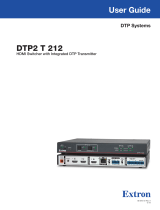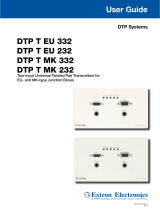Page is loading ...

1
DTP3 T 101 D • Setup Guide
IMPORTANT NOTE:
Go to www.extron.com for the complete user guide, installation instructions, and specications
before connecting the product to the power source.
The DTP3 T 101 D is a one-gang decorator-style transmitter for sending HDMI signals up to 330 feet (100 meters) over a shielded CATx
cable to an Extron DTP-enabled product. It supports video resolutions up to 4096x2160 @ 60 Hz at 4:4:4 chroma sampling and complies
with HDMI 2.0 and HDCP 2.3. The DTP3 T 101 D provides reliable switching and transmission of HDMI signals.
This guide provides quick start instructions for an experienced installer to set up and operate the DTP3 T 101 D. For full installation,
conguration, and operation details, see the DTP3 T 101 D User Guide, available at www.extron.com.
DTP3 T 101 D
OUT
CONFIG
HDBTSEND POWER
DTPOFF
POWER
1.4A MAX
12V
RESET
a
HDMI IN
HDMI IN
AC
B
F
ED
G
Front Panel
Rear Panel
Top View
H
A HDMI input
B Power inlet
c Config port
D DTP/HDBT toggle switch
E Send Power toggle switch
F DTP output
G Reset button
H Power status LED
Figure 1. DTP3 T 101 D Front and Rear Panel Features
Step 1 — Disconnect Power
Disconnect all equipment power sources.
Step 2 — Prepare the Mounting Surface
ATTENTION:
• Installation and service must be performed by authorized
personnel.
• L’installation et l’entretien doivent être effectués par le personnel
autorisé uniquement.
• The unit must be installed in accordance with the National Electrical
Code and with local electrical and safety codes.
• L’unité doit être installée conformément au National Electric Code
et aux normes électriques et de sécurité locales.
Wall Stud
Screws
or Nails
Signal
Output
Cable
HDMI IN
a
Decorator-Style
Faceplate
Extron
DTP3 T 101 D
Transmitter
Figure 2. Wall Installation
NOTE: Use a wall box with a depth of at least 3.0 inches (7.6 cm). Alternatively, the included mud ring (MR 100) can be used. For more
information, see the full product user guide at www.extron.com.
a. Place the the wall box against the installation surface and mark the opening guidelines.
b. Cut out the material from the marked area.
c. Secure the wall box to the wall stud with 10-penny nails or #8 or #10 screws, leaving the front edge flush with the surface (see figure 2).
d. Run all required cables (see step 4 and step 5 on page 2) and secure them with cable clamps.
e. Do not install the transmitter into the box until step 7.
NOTE: In order to fit the unit in the junction box, do not install boots on TP cables and RJ-45 connectors.
1
2 Installation

2
DTP3 T 101 D • Setup Guide (Continued)
Step 3 — Connect the Input
Connect an HDMI cable between the HDMI input and the output of the digital video source (see gure1, A on page 1).
Step 4 — Set the DTP/HDBT and Send Power Toggle Switches
ATTENTION:
• Position these toggle switches (D and E) BEFORE
connecting the appropriate device to the TP connector.
Failure to comply can damage the endpoint.
• Positionnez ces sélecteurs (D and E) AVANT de
connecter l’appareil approprié au connecteur TP. Ne pas
respecter cette procédure pourrait endommager le point
de connexion.
• The DTP3 T 101 D device is configured to output power
to DTP3 models only. If connected to a legacy DTP or
HDBT device, set the Send Power toggle switch to the
OFF position (down). Failure to turn the power off will
damage the connected DTP device.
• Le DTP3 T 101 D est configuré pour fournir une
alimentation aux modèles DTP3 uniquement. S’il est
connecté à un autre appareil, veuillez positionner
l’interrupteur à bascule sur « OFF » (down). Si
l’interrupteur n’est pas positionné sur OFF, vous risquez
d’entraîner la défaillance de l’appareil legacy DTP
connecté.
• For DTP3 series receivers, set the DTP/HDBT toggle switch to
the DTP (down) position and the Send Power toggle switch to
the SEND POWER (up) position. On the receiver, set the Send
Power toggle switch to the OFF (down) position.
• For legacy DTP series, set the DTP/HDBT toggle switch to the
DTP (down) position and the Send Power toggle switch to the
OFF (down) position.
• If the receiver is HDBaseT enabled, set the DTP/HDBT toggle
switch to the HDBT (up) position and the Send Power toggle
switch to the OFF (down) position.
NOTE: When the output is congured for DTP mode, remote
power is available for Extron DTP3 devices only. When
the output is congured for HDBT mode, remote power is
disabled and both the switcher and receiver require their
own 12 VDC power supply.
DTP3 T 101 D
OUT
CONFIG
HDBTSEND POWER
DTPOFF
POWER
--A MAX
12V
RESET
SEND
POWER
OFF
SEND
POWER
OFF
SEND
POWER
OFF
OFF
OFF
SEND
POWER
OFF
ON
Local
Power Supply
CATx Cable
up to 330' (100 m)
No Remote Power
DTP3 T 101 D
OUT
CONFIG
HDBTSEND POWER
DTPOFF
POWER
--A MAX
12V
RESET
ON
Local
Power Supply
DTP3 T 101 D
OUT
CONFIG
HDBTSEND POWER
DTPOFF
POWER
--A MAX
12V
RESET
OFF
DTP HDMI 330 Rx
OVER DTP
RS-232 IR
Tx Rx Tx RxG
DTP3 R 201
CONFIG
DTP
SEND
PWR
OFF
SIGNAL
HDCP
e
DTP3 R 201
CONFIG
DTP
SEND
PWR
OFF
SIGNAL
HDCP
e
SEND
POWER
OFF
Local
Power Supply
Extron
DTP3 T 101 D
Transmitter
Extron
DTP HDMI 4K 330 Rx
Receiver
DTP3 Endpoint Connected to a DTP Endpoint
CATx Cable
up to 330' (100 m)
Direction of
Remote Power
Extron
DTP3 R 201
Receiver
DTP3 Endpoint Connected to a DTP3 Endpoint
Extron
DTP3 T 101 D
Transmitter
Extron
DTP3 T 101 D
Transmitter
CATx Cable
up to 330' (100 m)
Direction of
Remote Power
Extron
DTP3 R 201
Receiver
Local
Power Supply
Figure 3. Send Power Configuration
Step 5 — Connect the Output
Connect a RJ-45 DTP or HDBT receiving device to the output (F) for either DTP or HDBT mode.
ATTENTION:
• Do not use Extron UTP23SF-4 Enhanced Skew-Free AV UTP cable or STP201 cable.
• N’utilisez pas le câble AV Skew-Free UTP version améliorée UTP23SF d’Extron ou le câble
STP201.
For optimal performance, Extron highly recommends the following:
• RJ-45 termination with STP cable must comply with TIA/EIA T 568B wiring standard for all connections
(see image to the right to properly wire the RJ-45 connector).
• Use shielded twisted pair cable, 22 AWG solid conductor or better, with a minimum cable bandwidth of
500 MHz.
5
Pin
1
2
3
6
7
8
4
12345678
Insert Tw isted
Pair Wires
Pins:
RJ-45
Connector
Wire color
White-green
Green
White-orange
White-blue
Orange
White-brown
Brown
Blue
TIA/EIA T
568 B
• Limit the use of RJ-45 patches. Overall transmission distance capabilities vary depending on the number of patches used. If possible,
limit the number of patches to only one or two total.
• If RJ-45 patches must be used in the system, shielded CAT 6 (or better) patches are recommended.
HDMI input
DTP/HDBT toggle switchSend Power toggle switch
step 4
3
step 5
DTP output

3
Step 6 — Power the Device
When the unit is congured for DTP mode via the DTP/HDBT toggle switch (see gure1, D), the unit can be powered either locally, with
the included external 12 VDC power supply, or over the DTP line by a locally powered receiver or switcher.
When congured for HDBaseT mode, remote power capability is disabled, and
the unit must be powered locally.
To power the unit locally in either mode, wire the 2-pole captive screw
connector for the included external 12 VDC power supply (see image on the
right for wiring). Plug the power supply captive screw connector into the power
inlet (see gure1, B).
SECTION A–A
Ridges
Smooth
A
A
3/16"
(5 mm) Max.
POWER
12V
1.4A MAX
Step 7 — Final Installation
a. If needed, congure the device via the USB-C Cong port (C) before mounting in the wall box or mud ring.
b. Make all connections and test the system for satisfactory operation.
c. Secure all cables with cable clamps.
d. At the power outlet, if connected, unplug the power supply.
e. Mount the transmitter into the wall box and attach the supplied decorator-style faceplate to the unit (see figure 2 on page 1).
f. At the power outlet, reconnect the power supply.
g. Power up all attached devices, including displays.
Operation
After all devices are powered up, the system is fully operational. If any problems are encountered, verify that cables are routed and
connected properly and the display device has compatible resolution and refresh rate. See gure 4 for a typical application for the device.
Reset Button
The recessed button (see gure1, G) initiates two modes of reset on the transmitter. To initiate the dierent reset levels, use a pointed
object such as a small athead screwdriver or a stylus to press and hold the button while the transmitter is running or while it is being
powered up (see the DTP3 T 101 D User Guide for more details on the reset modes).
LED Indicator
The two-color front panel power status
LED (H) lights to indicate signal and
power status:
• Amber — Unit is receiving power
but no signal is present on the
HDMI input.
• Green — Unit is receiving power
and a signal is present on the
HDMI input, when connected to a
receiver and display.
Figure 4. Application Diagram
Power inlet
step 7
Config port
Reset button
Power status LED
4

4
68-3706-50 Rev. A
12 23
For information on safety guidelines, regulatory compliances, EMI/EMF compatibility, accessibility, and related topics, see the Extron Safety
and Regulatory Compliance Guide on the Extron website.
© 2023 Extron — All rights reserved. www.extron.com
All trademarks mentioned are the property of their respective owners.
Worldwide Headquarters: Extron USA West, 1025 E. Ball Road, Anaheim, CA 92805, 800.633.9876
/




